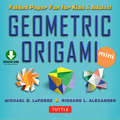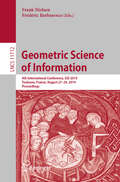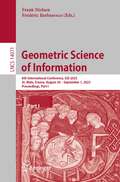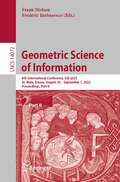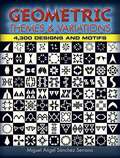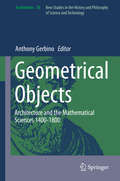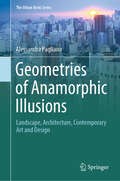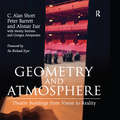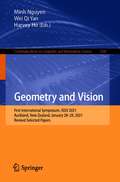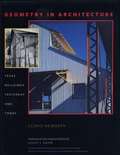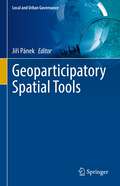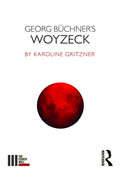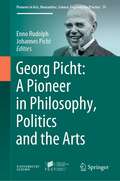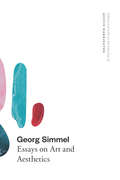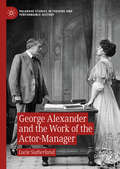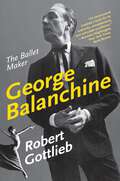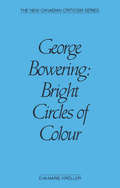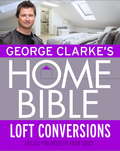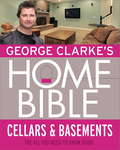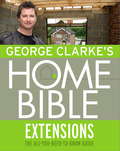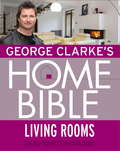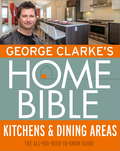- Table View
- List View
Geometric Origami Mini
by Richard L. Alexander Michael G. LafosseThis compact origami ebook contains everything you need to create beautiful, geometric origami sculptures. Art and math intertwine in exciting and complex new ways in Geometric Origami ebook. World renowned origami artists Michael G. LaFosse and Richard L. Alexander bring you this paper craft kit where folding a piece of paper creates a new and wondrous origami object. In Geometric Origami, the initial folds are easily created, but once the basic building blocks are ready, the intricate combining of these pieces form new geometric origami sculptures that interlock into interchangeable origami puzzles. Ideal for demonstrating the sophistication and wonder of geometry, they can also be great conversation starting decorations for the home or office. This ebook and downloadable material provide the beginning folder with a series of fun, modular origami projects that represent a wide variety of subjects and techniques. This origami ebook includes: Full-color 32-page book Step-by-step instructions and easy-to-follow diagrams At a glance, Geometric Origami may seem too difficult to attempt, but once the methods are broken down and explained they are quite simple and can be completed by children and or beginning origami students. The intricate, multi-paper origami sculptures will put your paper folding skills on a whole new level and are excellent for use in the classroom, for art, math or geometry investigations. Origami projects include: Harlequin Cube Chevron Pinwheel Dazzle Star Hedgehog Dado Stellated Octahedron
Geometric Origami Mini
by Richard L. Alexander Michael G. LafosseThis compact origami ebook contains everything you need to create beautiful, geometric origami sculptures.Art and math intertwine in exciting and complex new ways in Geometric Origami ebook. World renowned origami artists Michael G. LaFosse and Richard L. Alexander bring you this paper craft kit where folding a piece of paper creates a new and wondrous origami object. In Geometric Origami, the initial folds are easily created, but once the basic building blocks are ready, the intricate combining of these pieces form new geometric origami sculptures that interlock into interchangeable origami puzzles. Ideal for demonstrating the sophistication and wonder of geometry, they can also be great conversation starting decorations for the home or office. This ebook and downloadable material provide the beginning folder with a series of fun, modular origami projects that represent a wide variety of subjects and techniques.This origami ebook includes:Full-color 32-page book Step-by-step instructions and easy-to-follow diagramsAt a glance, Geometric Origami may seem too difficult to attempt, but once the methods are broken down and explained they are quite simple and can be completed by children and or beginning origami students. The intricate, multi-paper origami sculptures will put your paper folding skills on a whole new level and are excellent for use in the classroom, for art, math or geometry investigations.Origami projects include: Harlequin Cube Chevron Pinwheel Dazzle Star Hedgehog DadoStellated Octahedron
Geometric Science of Information: 4th International Conference, GSI 2019, Toulouse, France, August 27–29, 2019, Proceedings (Lecture Notes in Computer Science #11712)
by Frank Nielsen Frédéric BarbarescoThis book constitutes the proceedings of the 4th International Conference on Geometric Science of Information, GSI 2019, held in Toulouse, France, in August 2019.The 79 full papers presented in this volume were carefully reviewed and selected from 105 submissions. They cover all the main topics and highlights in the domain of geometric science of information, including information geometry manifolds of structured data/information and their advanced applications.
Geometric Science of Information: 6th International Conference, GSI 2023, St. Malo, France, August 30 – September 1, 2023, Proceedings, Part I (Lecture Notes in Computer Science #14071)
by Frank Nielsen Frédéric BarbarescoThis book constitutes the proceedings of the 6th International Conference on Geometric Science of Information, GSI 2023, held in St. Malo, France, during August 30-September 1, 2023. The 125 full papers presented in this volume were carefully reviewed and selected from 161 submissions. They cover all the main topics and highlights in the domain of geometric science of information, including information geometry manifolds of structured data/information and their advanced applications. The papers are organized in the following topics: geometry and machine learning; divergences and computational information geometry; statistics, topology and shape spaces; geometry and mechanics; geometry, learning dynamics and thermodynamics; quantum information geometry; geometry and biological structures; geometry and applications.
Geometric Science of Information: 6th International Conference, GSI 2023, St. Malo, France, August 30 – September 1, 2023, Proceedings, Part II (Lecture Notes in Computer Science #14072)
by Frank Nielsen Frédéric BarbarescoThis book constitutes the proceedings of the 6th International Conference on Geometric Science of Information, GSI 2023, held in St. Malo, France, during August 30-September 1, 2023. The 125 full papers presented in this volume were carefully reviewed and selected from 161 submissions. They cover all the main topics and highlights in the domain of geometric science of information, including information geometry manifolds of structured data/information and their advanced applications. The papers are organized in the following topics: geometry and machine learning; divergences and computational information geometry; statistics, topology and shape spaces; geometry and mechanics; geometry, learning dynamics and thermodynamics; quantum information geometry; geometry and biological structures; geometry and applications.
Geometric Themes and Variations: 4,300 Designs and Motifs (Dover Pictorial Archive)
by Miguel Angel Sánchez SerranoIn this amazing cache of designs, arresting displays of geometrics explode into thousands of fascinating variations. Each of forty-one original black-and-white motifs is spun into three pages of adaptations, offering strikingly different variations on the original theme. More than 4,300 images build upon basic geometric shapes, transforming circles, squares, rectangles, and triangles into intricate patterns that form kaleidoscopic designs, optical illusions, and hypnotic abstracts.A versatile resource for graphics, art, and craft projects, this collection offers not only a wealth of images for immediate practical use but also an excellent reference for design inspiration.
Geometrical Objects
by Anthony GerbinoThis volume explores the mathematical character of architectural practice in diverse pre- and early modern contexts It takes an explicitly interdisciplinary approach, which unites scholarship in early modern architecture with recent work in the history of science, in particular, on the role of practice in the "scientific revolution" As a contribution to architectural history, the volume contextualizes design and construction in terms of contemporary mathematical knowledge, attendant forms of mathematical practice, and relevant social distinctions between the mathematical professions As a contribution to the history of science, the volume presents a series of micro-historical studies that highlight issues of process, materiality, and knowledge production in specific, situated, practical contexts Our approach sees the designer's studio, the stone-yard, the drawing floor, and construction site not merely as places where the architectural object takes shape, but where mathematical knowledge itself is deployed, exchanged, and amplified among various participants in the building process.
Geometries of Anamorphic Illusions: Landscape, Architecture, Contemporary Art and Design (The Urban Book Series)
by Alessandra PaglianoThis book intends to focus exclusively on anamorphic experiments in contemporary art and design, leaving an in-depth historical examination of its Baroque season to other studies. Themes, languages and fields of application of anamorphosis in contemporary culture are critically analyzed to make the reader aware of the communicative potentiality of this kind of geometrical technique. The book also has the aim to teach the reader the most appropriate geometric techniques for each of them, in order to achieve the designed illusion. Each typology of anamorphosis is accompanied in this book by contemporary installations, a geometrical explanation by means of 3D models and didactic experiments carried on in collaboration with the students of the Department of Architecture in Naples.
Geometry and Atmosphere: Theatre Buildings from Vision to Reality
by Peter Barrett C. Alan Short Alistair Fair Monty SutrisnaDrawing on detailed design, construction and financial histories of six prominent Performing Arts buildings with budgets ranging from £3.4 million to over £100 million, Geometry and Atmosphere presents unique and valuable insights into the complex process of building for the arts. Each theatre project, from tailor-made spaces for avant-garde companies to iconic and innovative receiving houses, yields surprising and counter-intuitive findings. For each of the six projects, the authors have interviewed all those involved. Combining these interviews with exhaustive archival research, the authors then provide cross-case analysis which is distilled into guidance for all stakeholders as they transform their initial vision into built reality. In particular, the book challenges the technical focus of existing design guides for the Performing Arts by suggesting that current practice in briefing and design does not serve the Arts community especially well. It shows that there is a need for an approach in which the focus is firmly rooted in the delivery of the driving artistic vision. As well as being of interest to architects, urban designers and those involved in theatre studies, this book will be useful to other sectors where public money is spent on major building projects.
Geometry and Vision: First International Symposium, ISGV 2021, Auckland, New Zealand, January 28-29, 2021, Revised Selected Papers (Communications in Computer and Information Science #1386)
by Wei Qi Yan Minh Nguyen Harvey HoThis book constitutes selected papers from the First International Symposium on Geometry and Vision, ISGV 2021, held in Auckland, New Zealand, in January 2021. Due to the COVID-19 pandemic the conference was held in partially virtual format. The 29 papers were thoroughly reviewed and selected from 50 submissions. They cover topics in areas of digital geometry, graphics, image and video technologies, computer vision, and multimedia technologies.
Geometry in Architecture: Texas Buildings Yesterday and Today
by Clovis HeimsathPioneer Texas Buildings opened people's eyes when it was first published in 1968. At a time when "progress" meant tearing down the weathered houses, barns, churches, and stores built by the original settlers of Central Texas, this book taught people to see the beauty, simplicity, and order expressed in the unadorned geometric forms of early Texas buildings. It inspired the preservation and restoration of many of the remaining pioneer buildings, as well as the design of modern buildings that employ the same simple geometries. This revised edition of Pioneer Texas Buildings juxtaposes the historic structures with works by twenty contemporary architects who are inspired by the pioneer tradition to show how seamlessly the basic geometries translate from one era to another. As in the first edition, sketches and brief commentary by Clovis Heimsath explain how squares, triangles, and circles take shape in the cubic, triangular, and cylindrical forms that comprise houses and other buildings. Then black-and-white photographs, the heart of the book, illustrate these geometric forms in historic and modern buildings. The book also includes two essays in which Heimsath discusses the factors that led him and his wife Maryann to document early Texas buildings and the results in historic preservation and timeless architectural designs that have followed from their efforts.
Geoparticipatory Spatial Tools (Local and Urban Governance)
by Jiří PánekThe book explores the key factors affecting the successful implementation of public participation spatial systems in participatory planning as part of the urban governance system. It brings insight from nation-wide research in the Czech Republic and the implications to other countries in the region and beyond. The main aim of the proposed book is to analyse the state-of-the-art of using geoparticipatory tools for citizens’ participation in community decision-making process and to suggest the effective implementation of the geoparticipatory tools available in urban governance. This book explores the situation in the Czech Republic as a representative of for Eastern Bloc country, three decades after the political transition, on its way to public participation in local and urban governance. The active involvement of the citizens into the local and urban decision making process via geoparticipatory spatial tools is becoming a popular research field among human geographers, behavioural geographers, GIS scientists, environmental psychologists, policy scientists and many others scientific areas.
Georg Büchner's Woyzeck (The Fourth Wall)
by Karoline Gritzner'Everyone's an abyss. You get dizzy if you look down.' -- Woyzeck Georg Büchner’s Woyzeck was left unfinished at the time of its author’s death in 1837, but the play is now widely recognised as the first ‘modern’ drama in the history of European theatre. Its fragmentary form and critical socio-political content have had a lasting influence on artists, readers and audiences to this day. The abuse, exploitation, and disenfranchisement that Woyzeck’s titular protagonist endures find their mirror in his own murderous outburst. But beyond that, they also echo in the flux and confusion of the various drafts and versions in which the play has been presented since its emergence. In this fresh engagement with a modern classic, Gritzner examines the revolutionary dimensions of Büchner’s political and creative practice, as well as modern approaches to the play in performance.
Georg Picht: A Pioneer in Philosophy, Politics and the Arts (Pioneers in Arts, Humanities, Science, Engineering, Practice #19)
by Johannes Picht Enno RudolphAimed at an international readership, this book offers a representative collection of essays by the German philosopher, Georg Picht (1913-1982), who was a specialist in Greek philosophy, practical philosophy and philosophy of religion. Picht's themes address different disciplines, such as ancient philosophy, systematic philosophy and political analysis, and often contain critical statements on significant developments from the European Enlightenment to the Cold War era. Other essays offer a distinctive interdisciplinary approach characteristic of the author. These contributions are relevant to both philosophy and science as they discuss, for instance, philosophical definitions of space and time or the relationship between history and evolution. Another part of the book includes texts on art that present Picht’s authentic definition of art and his theory of the interdependence of art and politics.• For the first time, key texts of the German philosopher and political thinker Georg Picht are presented to a global readership in English.• Like Nietzsche’s philosophy, Picht’s work is grounded in his outstanding professionalism in the different fields of classics, embracing not only textsand theories of the great thinkers from the pre-Socratic to the post-Aristotelian and Stoic philosophies but also the main currents of ancient literature.• Picht’s importance as a political author and public adviser is exceptional, and may explain why his lifelong friend Carl Friedrich von Weizsäcker – another pioneer presented in this series – called him his “teacher”.
Georg Simmel: Essays on Art and Aesthetics (Heritage Of Sociology Ser.)
by Georg SimmelGeorg Simmel is one of the most original German thinkers of the twentieth century and is considered a founding architect of the modern discipline of sociology. Ranging over fundamental questions of the relationship of self and society, his influential writings on money, modernity, and the metropolis continue to provoke debate today. Fascinated by the relationship between culture, society, and economic life, Simmel took an interest in myriad phenomena of aesthetics and the arts. A friend of writers and artists such as Auguste Rodin, Rainer Maria Rilke, and Stefan George, he wrote dozens of pieces engaging with topics such as the work of Michelangelo, Rembrandt, and Rodin, Japanese art, naturalism and symbolism, Goethe, “art for art’s sake”, art exhibitions, and the aesthetics of the picture frame. This is the first collection to bring together Simmel’s finest writing on art and aesthetics, and many of the items appear in English in this volume for the first time. The more than forty essays show the protean breadth of Simmel’s reflections, covering landscape painting, portraiture, sculpture, poetry, theater, form, style, and representation. An extensive introduction by Austin Harrington gives an overview of Simmel’s themes and elucidates the significance of his work for the many theorists who would be inspired by his ideas. Something of an outsider to the formal academic world of his day, Simmel wrote creatively with the flair of an essayist. This expansive collection of translations preserves the narrative ease of Simmel’s prose and will be a vital source for readers with an interest in Simmel’s trailblazing ideas in modern European philosophy, sociology, and cultural theory.
George A. Romero: Interviews (Conversations with Filmmakers Series)
by Tony WilliamsGeorge A. Romero (b. 1940) has achieved a surprising longevity as director since his first film, Night of the Living Dead (1968). After relocating to Canada, he shows no signs of slowing up: his recent film, Survival of the Dead (2009), is discussed in a new interview conducted by Tony Williams for this volume, and still other films are awaiting release. Although commonly known as a director of zombie films, a genre he himself launched, Romero's films often transcend easy labels. His films are best understood as allegorical commentaries on American life that just happen to appropriate horror as a convenient vehicle. Romero's films encompass works as different as The Crazies, Hungry Wives, Knightriders, and Bruiser. The interviews in this collection cover a period of over forty years. In whatever format they originally appeared—the printed page, the internet, or the video interview—these discussions illustrate both the evolution of Romero's chosen forms of technology and the development of his thinking about the relationship between cinema and society. They present Romero as an independent director in every sense of the word.
George Alexander and the Work of the Actor-Manager (Palgrave Studies in Theatre and Performance History)
by Lucie SutherlandIn the first book-length study of the work and legacy of West End actor-manager George Alexander since the 1930s, George Alexander and the Work of the Actor Manager examines the key part this figure played in presenting new drama by authors including Oscar Wilde and Henry James. The book sheds new light on the figure of the actor-manager, assessing in detail the influence of Alexander within and beyond his time.At the St. James’s Theatre in London between 1891 and 1918, through a range of strategies including the support of new writers, and adaptation of fiction to the stage, Alexander sustained professional status through practices that continue to be reflected in the cultural industries today. A range of evidence is employed including production reviews, anecdotal accounts, financial records, and personal correspondence, to reveal how he operated as a business entrepreneur as well as an artistic innovator.
George Balanchine: The Ballet Maker (Eminent Lives)
by Robert GottliebThe foremost contemporary choreographer in the history of ballet, George Balanchine extended the art form into radical new paths that came to seem inevitable under his direction. He transformed movement and dance in classical and modern ballet, on the Broadway stage, and in the cinema.George Balanchine chronicles the life and achievements of this visionary artist from his early, almost accidental career in Russia, where his lifelong collaboration with Igor Stravinsky was forged, to his extraordinary accomplishments in America. The editor and writer Robert Gottlieb, one of the most knowledgeable dance critics in America, offers a superb and loving portrait of a genius who, though married many times to many ballerinas, remained truest to his greatest love, Terpischore, the Greek Muse of dance.
George Bowering: Bright Circles of Colour
by Eva-Marie KröllerThis first book-length study of Bowering explores the relationship between his work and the arts.
George Clarke's Home Bible: Bedrooms and Loft Conversions
by George ClarkeThe ROOM BY ROOM series is a set of short essential guides to transform your house into your ideal home. Each one is full of top tips and golden rules from award-winning architect and TV home-improvement guru George Clarke. From designing layouts, budgeting and lighting advice, through to storage solutions, tricks of the trade, finishes, materials and a fully comprehensive resources guide, these guides will fully equip you with all the information you need to improve the space you live in.For novices and experts alike, this is the one-stop guide to getting the best out of your loft conversion.
George Clarke's Home Bible: Cellars and Basements
by George ClarkeThe ROOM BY ROOM series is a set of short essential guides to transform your house into your ideal home. Each one is full of top tips and golden rules from award-winning architect and TV home-improvement guru George Clarke. From designing layouts, budgeting and lighting advice, through to storage solutions, tricks of the trade, finishes, materials and a fully comprehensive resources guide, these guides will fully equip you with all the information you need to improve the space you live in.For novices and experts alike, this is the one-stop guide to getting the best out of your cellar and basement.
George Clarke's Home Bible: Extensions
by George ClarkeThe ROOM BY ROOM series is a set of short essential guides to transform your house into your ideal home. Each one is full of top tips and golden rules from award-winning architect and TV home-improvement guru George Clarke. From designing layouts, budgeting and lighting advice, through to storage solutions, tricks of the trade, finishes, materials and a fully comprehensive resources guide, these guides will fully equip you with all the information you need to improve the space you live in.For novices and experts alike, this is the one-stop guide to creating the best extension for your home.
George Clarke's Home Bible: Living Rooms
by George ClarkeThe ROOM BY ROOM series is a set of short essential guides to transform your house into your ideal home. Each one is full of top tips and golden rules from award-winning architect and TV home-improvement guru George Clarke. From designing layouts, budgeting and lighting advice, through to storage solutions, tricks of the trade, finishes, materials and a fully comprehensive resources guide, these guides will fully equip you with all the information you need to improve the space you live in.For novices and experts alike, this is the one-stop guide to getting the best out of your living room.
George Clarke's Home Bible: Studies
by George ClarkeThe ROOM BY ROOM series is a set of short essential guides to transform your house into your ideal home. Each one is full of top tips and golden rules from award-winning architect and TV home-improvement guru George Clarke. From designing layouts, budgeting and lighting advice, through to storage solutions, tricks of the trade, finishes, materials and a fully comprehensive resources guide, these guides will fully equip you with all the information you need to improve the space you live in.For novices and experts alike, this is the one-stop guide to getting the best out of your study.
George Clarke's Home Bible: The All-You-Need-To-Know Guide
by George ClarkeThe ROOM BY ROOM series is a set of short essential guides to transform your house into your ideal home. Each one is full of top tips and golden rules from award-winning architect and TV home-improvement guru George Clarke. From designing layouts, budgeting and lighting advice, through to storage solutions, tricks of the trade, finishes, materials and a fully comprehensive resources guide, these guides will fully equip you with all the information you need to improve the space you live in.For novices and experts alike, this is the one-stop guide to getting the best out of your kitchen and dining room.
